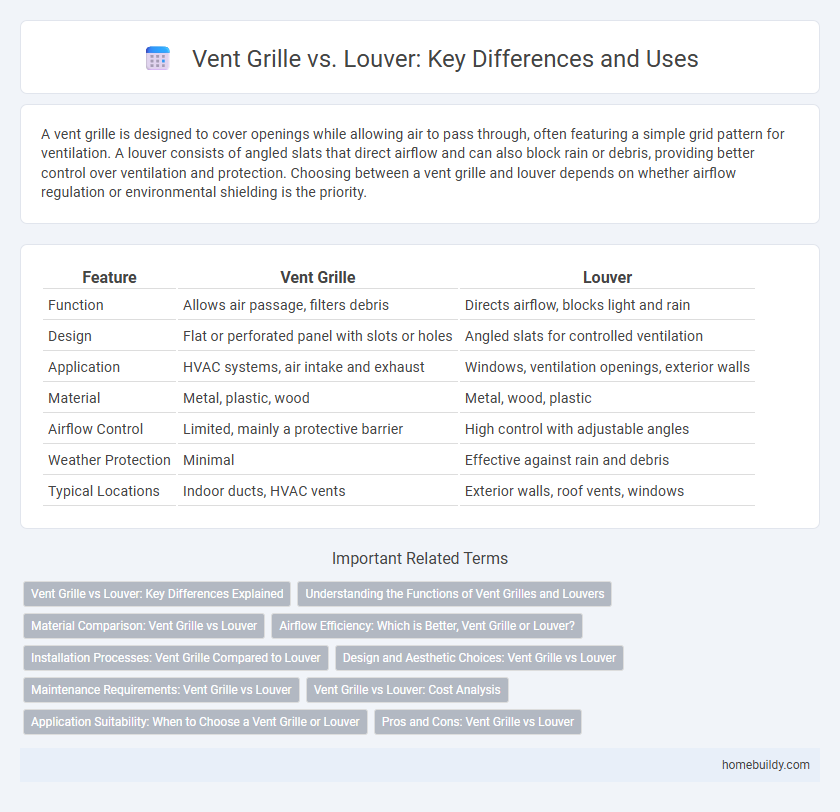A vent grille is designed to cover openings while allowing air to pass through, often featuring a simple grid pattern for ventilation. A louver consists of angled slats that direct airflow and can also block rain or debris, providing better control over ventilation and protection. Choosing between a vent grille and louver depends on whether airflow regulation or environmental shielding is the priority.
Table of Comparison
| Feature | Vent Grille | Louver |
|---|---|---|
| Function | Allows air passage, filters debris | Directs airflow, blocks light and rain |
| Design | Flat or perforated panel with slots or holes | Angled slats for controlled ventilation |
| Application | HVAC systems, air intake and exhaust | Windows, ventilation openings, exterior walls |
| Material | Metal, plastic, wood | Metal, wood, plastic |
| Airflow Control | Limited, mainly a protective barrier | High control with adjustable angles |
| Weather Protection | Minimal | Effective against rain and debris |
| Typical Locations | Indoor ducts, HVAC vents | Exterior walls, roof vents, windows |
Vent Grille vs Louver: Key Differences Explained
Vent grilles and louvers both regulate airflow but serve distinct purposes in HVAC systems, with vent grilles primarily designed for air intake or exhaust and louvers focused on blocking debris and water while allowing ventilation. Vent grilles typically feature a fixed or adjustable set of horizontal or vertical bars that control airflow direction, whereas louvers have angled slats specifically engineered to prevent rain and debris infiltration. Understanding these differences is essential for optimal ventilation design and selecting the right component based on environmental needs and airflow requirements.
Understanding the Functions of Vent Grilles and Louvers
Vent grilles primarily control airflow by allowing air to enter or exit HVAC systems while providing protection against debris and insects, whereas louvers are designed to manage air direction and prevent water ingress through angled slats. Vent grilles typically feature open or perforated patterns for maximum airflow efficiency, while louvers use angled blades that can be fixed or adjustable for airflow regulation. Understanding their distinct functions helps optimize ventilation system performance, ensuring effective air circulation and environmental protection.
Material Comparison: Vent Grille vs Louver
Vent grilles and louvers are commonly made from materials such as aluminum, steel, and plastic, each offering distinct durability and corrosion resistance properties. Aluminum vent grilles provide lightweight strength and excellent rust resistance, making them ideal for both indoor and outdoor applications, while steel variants offer superior sturdiness but require protective coatings to prevent corrosion. Plastic louvers excel in moisture resistance and cost-effectiveness, though they may lack the mechanical strength and longevity found in metal alternatives.
Airflow Efficiency: Which is Better, Vent Grille or Louver?
Vent grilles generally offer higher airflow efficiency due to their larger open area and minimal obstruction, allowing for better ventilation and air circulation compared to louvers. Louvers, designed with angled slats primarily for directing airflow and providing protection against rain or debris, tend to restrict airflow slightly more than vent grilles. For applications emphasizing maximum airflow with minimal resistance, vent grilles are typically the preferred choice over louvers.
Installation Processes: Vent Grille Compared to Louver
Vent grilles typically feature straightforward installation processes involving simple mounting on walls, ceilings, or floors with screws or clips, ensuring secure airflow control. Louvers require more precise alignment and often need integration with exterior building elements or ductwork for optimal weather protection and air deflection. Compared to louvers, vent grilles offer quicker and easier installation, making them practical for indoor HVAC systems.
Design and Aesthetic Choices: Vent Grille vs Louver
Vent grilles typically feature a uniform pattern of slats that provide a sleek, clean appearance suitable for modern interiors, while louvers display angled blades designed to direct airflow and add dimensional texture to surfaces. The flat, symmetrical design of vent grilles blends seamlessly with walls or ceilings, creating minimal visual disruption, whereas louvers often serve as architectural elements that contribute to a dynamic, industrial aesthetic. Choosing between a vent grille and a louver hinges on balancing airflow direction needs with desired visual impact in residential or commercial spaces.
Maintenance Requirements: Vent Grille vs Louver
Vent grilles generally require less maintenance compared to louvers due to their simpler design with fewer moving parts, reducing the risk of mechanical failure. Louvers, equipped with adjustable blades, demand regular cleaning and lubrication to ensure smooth operation and prevent dust buildup that can impede airflow. Choosing vent grilles can optimize long-term maintenance efficiency in HVAC systems where minimal upkeep is preferred.
Vent Grille vs Louver: Cost Analysis
Vent grilles typically offer a more cost-effective solution compared to louvers due to simpler design and easier manufacturing processes, reducing both material and installation expenses. Louvers, designed primarily for weather protection and airflow control, tend to incur higher costs associated with their angled blades and additional sealing features. Choosing between vent grilles and louvers depends on budget constraints and functional requirements, with vent grilles favored in low-cost ventilation applications.
Application Suitability: When to Choose a Vent Grille or Louver
Vent grilles are ideal for applications requiring air distribution and filtration in HVAC systems, offering effective airflow control and dust protection. Louvers excel in exterior use due to their angled slats that prevent water penetration while allowing ventilation, making them suitable for building facades and mechanical rooms. Choose vent grilles for indoor air quality management and louvers for weather-resistant ventilation needs.
Pros and Cons: Vent Grille vs Louver
Vent grilles offer superior airflow control and easy maintenance, making them ideal for HVAC systems requiring efficient air distribution and filtering. Louvers provide enhanced weather protection and prevent debris ingress but can restrict airflow more than vent grilles. Choosing between a vent grille and a louver depends on the balance needed between ventilation efficiency and environmental protection for a specific application.
vent grille vs louver Infographic

 homebuildy.com
homebuildy.com